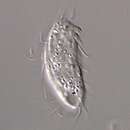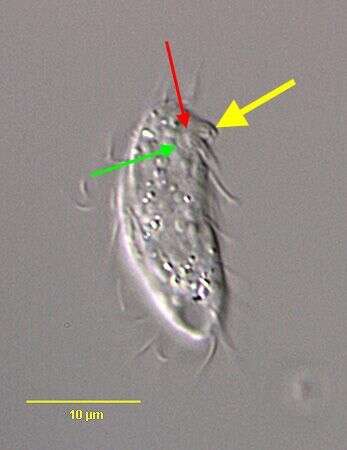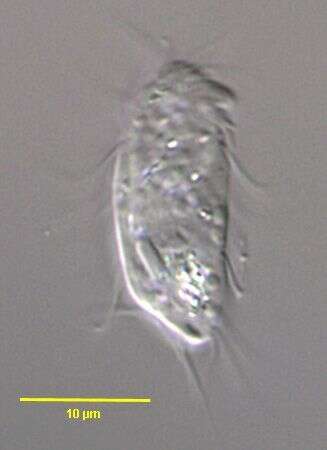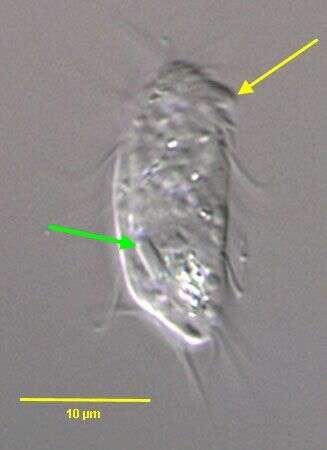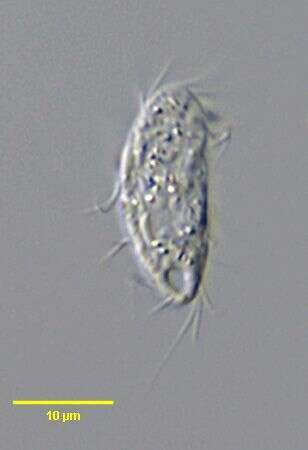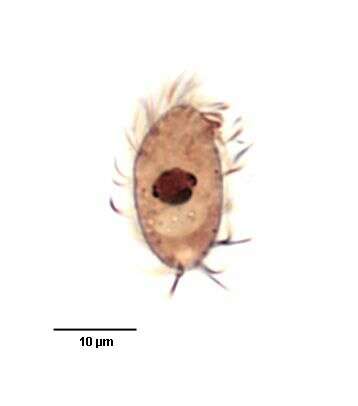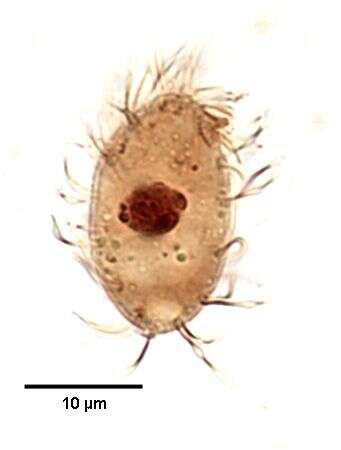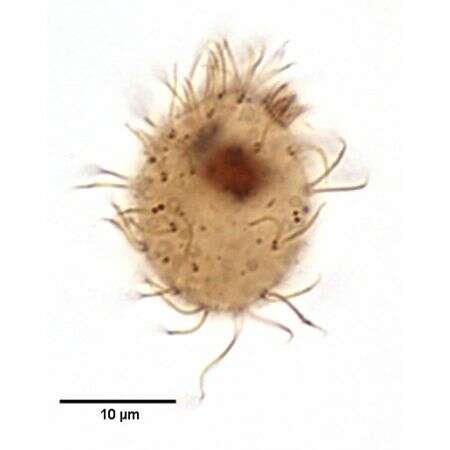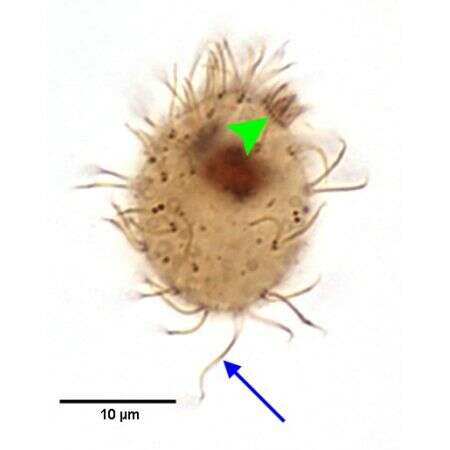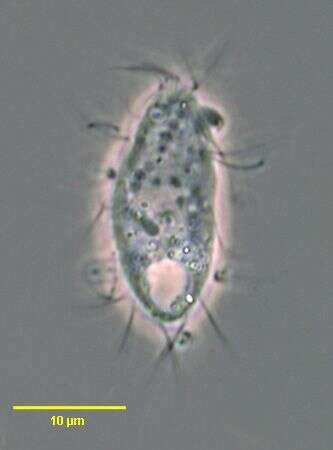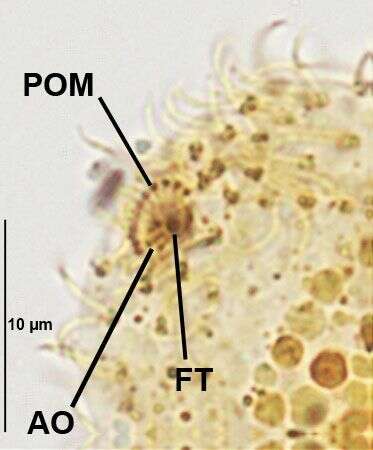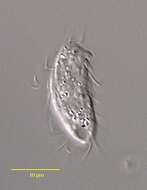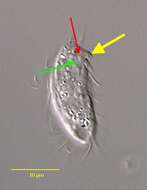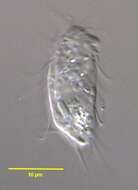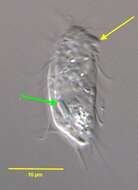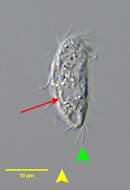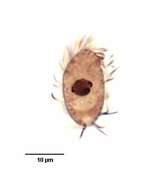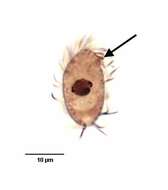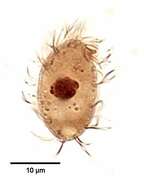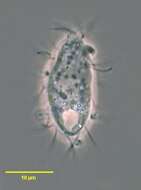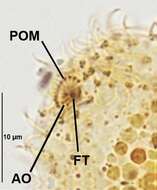-
Pseudoplatyophrya nana (KAHL,1926) FOISSNER,1980.DIC.
-
Pseudoplatyophrya nana (KAHL,1926) FOISSNER,1980.The large yellow arrow indicates the feeding tube specialized for the puncture of fungal cells upon which P. nana feeds. This tube projects from the ventral surface of the cell.The red arrow indicates the small adoral organelle composed of about 7 ciliated kinetids just posterior to the base of the feeding tube. The green arrow indicates the curved paraoral membrane to the right of the feeding tube. From a non-flooded Petri dish culture of topsoil collected at a public park in Boise, Idaho.November 2006.DIC.
-
Pseudoplatyophrya nana (KAHL,1926) FOISSNER,1980.DIC.
-
Pseudoplatyophrya nana (KAHL,1926) FOISSNER,1980.The yellow arrow indicates the feeding tube by which P. nana punctures and feeds on fungi and yeast cells. The green arrow indicates the unusually large oblong micronucleus.DIC.
-
Pseudoplatyophrya nana (KAHL,1926) FOISSNER,1980.DIC.
-
Pseudoplatyophrya nana (KAHL,1926) FOISSNER,1980.The red arrow indicates the large refractile bean-shaped micronucleus. The micronucleus conforms to the surface of the macronucleus but lies outside the nuclear envelope. One of the two cilia of the posterior terminal dikineted of of kinety 2 is elongated to almost the length of the cell (yellow arrowhead). The shorter cilium of the pair is shown by the green arrowhed). DIC.
-
Pseudoplatyophrya nana (KAHL,1926) FOISSNER,1980.Stained by the silver carbonate technique (see Foissner, W. Europ. J. Protistol., 27:313-330;1991).Brightfield.
-
Oral infraciliature Pseudoplatyophrya nana (KAHL,1926) FOISSNER,1980.Brightfield.Stained by the silver carbonate technique (see Foissner, W.Europ. J. Protistol.27:313-330;1991).Brightfield.
-
Pseudoplatyophrya nana (KAHL,1926) FOISSNER,1980.Stained by the silver carbonate technique (see Foissner, W.Europ. J. Protistol.27:313-330;1991).Brightfield.
-
Oral infraciliature Pseudoplatyophrya nana (KAHL,1926) FOISSNER,1980.The black arro indicates the feeding tube. The kinetids of the curved paraoral membrane are indicated by the green arrowhead. The light blue arrowheads indicate two of the prominent peripheral nucleoli in the macronucleus. The blue arrow indicates a ciliated somatic dikinetid. Stained by the silver carbonate technique (see Foissner, W.Europ. J. Protistol.27:313-330;1991).Brightfield.
-
Oral infraciliature Pseudoplatyophrya nana (KAHL,1926) FOISSNER,1980.Stained by the silver carbonate technique (see Foissner, W.Europ. J. Protistol.27:313-330;1991).Brightfield.
-
Oral infraciliature Pseudoplatyophrya nana (KAHL,1926) FOISSNER,1980.The kinetids of the curved paraoral membrane and their short stiff cilia are seen here (green arrowhead). the long caudal cilium is also seen (blue arrow). Stained by the silver carbonate technique (see Foissner, W.Europ. J. Protistol.27:313-330;1991).Brightfield.
-
Oral infraciliature Pseudoplatyophrya nana (KAHL,1926) FOISSNER,1980.From a non-flooded Petri dish culture of topsoil collected at a public park in Boise, Idaho.November 2006. Phase contrast.
-
Oral infraciliature Pseudoplatyophrya nana (KAHL,1926) FOISSNER,1980.There is a curved paraoral membrane (POM) and a small adoral membranelle consisting of 3 rows with 2,3 and 2 basal bodies. P. nana feeds on the contents of fungal and yeast cells after puncturing their walls by means of the specialized feeding tube (FT) seen here end-on.Found in a non-flooded Petri dish culture of cryptobiotic soil collected from the high desert sage brush habitat of southern Utah (37°48'17" N 111°32'45" W elev. 6417 ft).Stained by the silver carbonate technique (see Foissner, W. Europ. J. Protistol., 27:313-330;1991).Brightfield.

